Fremontodendron
Fremontodendron, with the common names fremontia,[1] flannelbush, and flannel bush, is a genus of three known species of shrubs native to the Southwestern United States and northwest Mexico.[2][3]
| Flannelbush | |
|---|---|
 | |
| Fremontodendron 'Ken Taylor' (F. californicum × F. mexicanum') | |
| Scientific classification | |
| Kingdom: | Plantae |
| Clade: | Tracheophytes |
| Clade: | Angiosperms |
| Clade: | Eudicots |
| Clade: | Rosids |
| Order: | Malvales |
| Family: | Malvaceae |
| Subfamily: | Bombacoideae |
| Genus: | Fremontodendron Coville |
| Species | |
| |
| Synonyms | |
|
Fremontia Torr. nom. illeg. | |
Taxonomy
They are within the botanical family Malvaceae. Formerly they were treated within the Sterculiaceae, tribe Fremontodendreae, together with the genus Chiranthodendron. The genus Fremontodendron was named in dedication to John C. Frémont,[4] who first collected it during an 1846 expedition to Alta California.
Description
The leaves have a leathery and fuzzy texture reminiscent of flannel (thus the name), and the yellow to orange flowers are large and showy. The leaves and young shoots can cause skin and eye irritation.


Species
There are three species:
- Fremontodendron californicum — Californian flannelbush
- Fremontodendron decumbens (R. Lloyd) — Pine Hill flannelbush [5][6][7]
- A decumbent and low spreading form, 3 feet (0.91 m) in height and 6 feet (1.8 m) in width, has yellow-orange flowers, and is endemic to the Sierra Nevada foothills, nearly all of the individuals of this subspecies are found in the Pine Hill Ecological Reserve in El Dorado County. In nature it only grows in metal-rich gabbro soil, a red weathered soil of volcanic origin. It requires fire for seed germination, but with the nature reserve is near human settlements fire ecology is suppressed. It is a federally listed endangered species.
- Fremontodendron mexicanum — Mexican flannelbush
- Endemic to the central Peninsular Ranges, known from about ten occurrences in northern Baja California state and adjacent southern San Diego County, California. However, it has most recently been confirmed to exist in only two of those locales currently.[8]
There are a number of populations of uncertain taxonomy status. They include:
- Fremontodendron californicum ssp. napensis — Napa fremontia
- The current Jepson manual does not recognize this subspecies, using Fremontodendron californicum, but the form is different enough that it is horticulturally recognized by this name. It is typically smaller and more open in form than the species, with much smaller leaves and flowers. It grows 6–15 feet (1.8–4.6 m) in height and 4–12 feet (1.2–3.7 m) in width.[9]
Cultivation
Fremontodendrons are cultivated as ornamental plants. They are valued for their bright yellow flowers, produced over a long period on a rapidly growing shrub or small tree. They are tolerant of pruning for size or shaping. They are adapted to dry, poor soils in a summer-dry, warm, sunny climate. They may succumb to root rot in heavy clay soils and/or summer irrigation.
The three species and varied hybrids/cultivars are used in native plant, water-conserving, and wildlife gardens in California. They are also planted in gardens in England.

Hybrids
There are several named hybrids of Fremontodendron californicum and Fremontodendron mexicanum in the horticultural trade, they include:
- Fremontodendron 'California Glory' — lemon-yellow flowers with a reddish tinge, grows 20 feet (6.1 m) in height by 20 feet (6.1 m) in width. It is the winner of the Award of Garden Merit from the California Horticultural Society in 1965, and received a First Class Certificate from the Royal Horticultural Society in 1967.[10][11]
- Fremontodendron 'Ken Taylor' — golden flowers with a darker orange outside petals in the spring and summer, and grows to only 5 feet (1.5 m) in height by 8–10 feet (2.4–3.0 m) in width.[12]
- Fremontodendron 'Dara's Gold' — golden flowers over a long period from late winter through early summer, grows 3 feet (0.91 m) in height by 6–8 feet (1.8–2.4 m) in width. A hybrid between Fremontodendron decumbens and Fremontodendron mexicanum.[13]
References
- Meyer, Susan E (2008). "Fremontodendron Coville" (PDF). USDA FS Agriculture Handbook 727 - The Woody Plant Seed Manual. USDA Forest Service. Retrieved 4 March 2013.
- USDA PLANTS: Classification . accessed 2.28.2015
- CalFlora Database: Fremontia species . accessed 2.28.2015
- Michael L. Charters. "Botanical Names: F". California Plant Names: Latin and Greek Meanings and Derivations. Sierra Madre, CA. Retrieved September 24, 2009.
- Calflora: Fremontodendron decumbens . accessed 2.28.2015
- USDA Plants Profile for Fremontodendron decumbens (Pine Hill flannelbush) . accessed 2.28.2015
- Jepson eFlora: Fremontodendron decumbens . accessed 2.28.2015
- California Native Plant Society Rare Plant Profile
- Theodore Payne Foundation, California Natives Wiki: Fremontodendron californica ssp. napense (Napa Fremontia)
- "Fremontodendron 'California Glory'". RHS. Retrieved 5 July 2020.
- San Marcos Growers: Fremontodendron 'California Glory'
- San Marcos Growers: Fremontodendron 'Ken Taylor'
- San Marcos Growers: Fremontodendron 'Dara's Gold'
External links
| Wikimedia Commons has media related to Fremontodendron. |
- CalFlora Database: Species of genus Fremontodendron
- Malvaceae.info: Fremontodendreae webpages (Fremontodendron and Chiranthodendron)
- Pinehillpreserve.org: Pine Hill Flannelbush (Fremontodendron decumbens) — in the Pine Hill Ecological Reserve